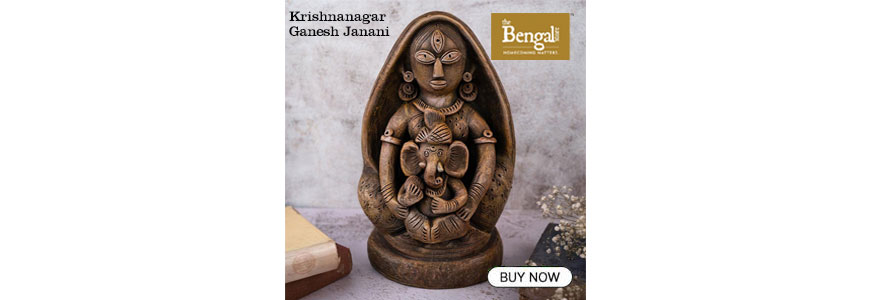Dashavatar Rakhis of Bishnupur revive the ancient tradition of Bengal’s Dashavatar Taash – GetBengal story
India is a hotpot of a variety of cultures, ethnicities, religions, and races and celebrates many festivals that are unique to the sub-continent. Rakhi, or Raksha Bandhan, is a celebration of the bond between brothers and sisters. Raksha Bandhan in Sanskrit means "the knot of protection." Even though the ceremonies differ depending on the region, they invariably involve tying a thread. The sister fastens a vibrant, occasionally elaborate thread around her brother's wrist. The thread is a symbol of the sister's kind thoughts and prayers for her brother. The brother then presents his sister with a gift. Raksha Bandhan was mentioned in the stories of Alexander the Great as early as 326 BCE. There are also several mentions of Raksha Bandhan in Hindu scriptures.
![]()
Shilpa Sutradhar, a young craftsperson from Bishnupur, has been at the forefront of an innovative project this year where she designed a collection of rakhis in the form of Dashavatar (10 incarnations of Lord Vishnu) cards, which is a part of the rich heritage of Bishnupur. The 10 avatars (incarnations) of Lord Vishnu—Matsya (fish), Kurma Tortoise, Baraha (boar), Nrisingha (half-man, half-lion), Baaman (midget/dwarf), Parshuram (the sixth incarnation with an axe), Ram (Lord Rama, the hero of the Ramayana), Balaram (brave brother of Lord Krishna), Buddha (Lord Jagannath, the ninth incarnation with absolute peace), and Kalki (the incarnation yet to be born on Earth) are hand-painted on these rakhis.
Shilpa mentions, “According to legend, the 16th-century Malla king, Bir Hambir, who ruled over Mallabhum, which chiefly covered West Bengal’s present-day Bankura district, was a friend of the Mughal emperor Akbar. He used to enjoy playing card games when he visited Delhi, and this gave him the idea to make his own. He created the Dashavatar cards, which are now associated with the capital of the former Mallabhum, Bishnupur. To preserve the concept of these cards, I thought of replicating them on the rakhis.”
![]()
As per historical records, Bir Hambir (who ruled from 1565 to 1620) invented the Dashavatar cards so that he could have bloodless entertainment. Dashavatar cards are a part of the rich heritage of West Bengal. However, the ‘Dashavatar card game’ is a complicated one, played using 120 cards and with many complex rules. But times have changed, and craftsmen have lost a large part of their market for Dashavatar cards. Most people are no longer interested in the card game. Amid this scenario, Shilpa Sutradhar, who has been making knick-knack items and jewellery with clay, beads, ceramic, fibre, wood, and cloth, decided to try her hands at making rakhis this year, and after several brainstorming sessions, she hit upon the idea of designing rakhis in the form of Dashavatar cards and selling them in the market.
The rakhis that Shilpa has created are exquisite pieces of art and carry the signature of the Bishnupur gharana (school or lineage). The rakhis have different incarnations of Lord Vishnu and are basically smaller versions of the traditional Dashavatar cards. The rakhi-making process is similar to the card-making process. Using tamarind seed adhesive, three pieces of cloth are first adhered to one another. A layer of chalk dust is applied to the cards once the glue has dried. A polished stone evens out both sides. After that, the base is sliced into circles large enough to encircle the wrist. Bright colours are used to paint the deities and symbols on the cards. A layer of vermillion and lac is put on the backs of the cards. The base has vibrant silk strings that can be tied around the wrist. The rakhis are very cost-effective, at Rs 40 and Rs 50 for a unit.
![]()
According to historical accounts, the Dashavatar 'taash' (card) makers of Bishnupur still refer to their uniquely designed playing cards as Ganjifa, a name that the Mughals used. The original Dashavatar cards are said to have been made in Bishnupur by an artisan called Kartik Faujdar, who followed Hambir's meticulous instructions. His descendants are apparently the only artists in the nation currently producing these one-of-a-kind pieces of art. The royals of Mallabhum (mostly modern-day Bankura, ruled by the Malla kings, of whom Hambir was the 49th) were delighted with Kartik's efforts, and the Dashavatar card game rapidly gained popularity. However, an alternative version put forward by renowned historian and scholar Haraprasad Shastri says that the cards originated in the 8th century AD or thereabouts. As already mentioned, the Faujdars are the only family still engaged in the art of making these cards. Inevitably, their art has undergone many evolutions to keep up with the changing times. Dashavatar packages once included 120 cards, but they are currently far fewer in quantity. This significantly decreased the effort and cost involved in producing them. But since there are fewer cards in the pack, they are ideal as decorative pieces rather than suitable for use in a game.
As per Bhagavat Puran and Vishnu Puran, after Vishnu conquered the three worlds from King Bali, King Bali asked Vishnu to live in his palace. Goddess Lakshmi, Vishnu’s wife, was unhappy about this arrangement. She tied a rakhi on King Bali's wrist, accepting him as her brother. Honoured by the gesture, King Bali granted her a wish, and Lakshmi requested that Vishnu return home. In addition, in Mahabharat, Draupadi tied a Rakhi on Krishna, another incarnation of Vishnu, before he left to fight in the Great War.
![]()
This year, Rakhsha Bandhan will be celebrated on August 19, and the market is already flooded with a wide range of colourful rakhis. These beautiful rakhis in gorgeous colours, shapes, and motifs are in great demand. But those who wish to make a statement can try out Bengal’s Dashavatar Rakhis, which uphold an almost lost ancient tradition.










